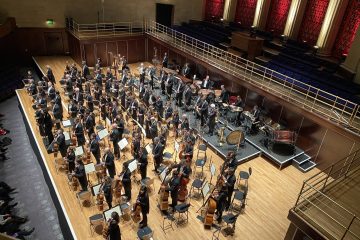Dearest classical music fans, welcome to a brand new strand of Classicalexburns! As well as now doing CD reviews, I am also beginning to try some reviews of other events, such as conferences, concerts and music events. To kick things off, I am going to share my experience of playing with Sheffield Philharmonic Orchestra in their latest concert, where we played the following programme:
I. Beethoven: Leonore Overture No. 1
II. Weber: Bassoon Concerto (Soloist: Stanley Kaye-Smith)
III. Mendelssohn: Symphony No. 3 “Scottish”
A very balanced programme of some well-loved classical era pieces. I’m also going to try to give you an idea of what it’s like sitting on the second trumpet seat, in the middle of the orchestra, and what that feels like when playing music like this.
Some of you may know, that trumpet players are often very good at counting, as that is what we mainly do in orchestras. This is true to some extent for this concert, although I do feel we played a lot more than in some other classical era works I have played. We were sat next to the lower woodwinds (bassoons and clarinets), so we got to hear some of their beautiful solo lines, as well as being able to hear their incredibly important foundation parts, that set the important harmonies up. To the other side of me, I had the timpani, which was utilised very well throughout, giving us important tonic-dominant stabs (usually with the trumpets) and fundamental rhythmic phrases. In front of us were the violas and cellos, who offer lots of accompaniments, but also melodic lines. So, from this you can have a guess that we were sat in a decent position in the orchestra, as we get the best of both worlds.
The concert began with the Beethoven. A strong set of Beethovian chords set the orchestra off on what was, what I consider, as a successful interpretation of the brilliant Leonore No. 1. Jack Lovell, the conductor, was clear in his beating, generous in his cue giving, and friendly in his approach to working with an orchestra of mixed abilities. Although perhaps slightly lacking on intonation at times, the strings were definitely a driven bunch, which is what added to the charm of playing with them. A well-handled interpretation from Jack, gave the orchestra the confidence to sing out the solo lines, come together for the tutti sections, and of course, most importantly, keep the trumpets awake after counting for over 100 bars at a time!
Weber’s Bassoon Concerto was next up in the programme. I was very excited by the prospect of not only playing this work, but hearing the very highly regarded Stanley Kaye-Smith (bassoon soloist) play. Before coming to the concert I had multiple conversations with people about how dedicated a player Stanley is, and how I’m in for a treat, and I was not disappointed. At times, I nearly missed cues because I was in such a trance watching him play. Not only was every note placed precisely, his sound was wonderful in every way, and I feel very lucky to have been an, albeit small, part in this concerto. What astounded me the most was the fact he was off score for the entire concerto, a very impressive feat for any virtuoso soloist. The orchestra, of course, made an invaluable contribution to the concerto, by being empathetic in their dynamics, as to not wash out the soloist. The tutti sections were grand and well-played. The Adagio movement was well controlled by both Stanley, Jack and strings, adding to the sincerity of the concerto. A really fantastic interpretation of this brilliant concerto – bravo all!
You can read my blog on Weber’s concerto here.
After the interval, the orchestra prepared to tackle Mendelssohn’s third symphony, also referred to as ‘The Scottish Symphony’. This work is fantastic, and a great choice for a programme such as this. It showcases perhaps every instrument in some way, whether that’s woodwind solos, trumpet fanfares, violin melodic lines, or timpani rolls, this symphony really showed the audience what this orchestra can achieve. Again, Jack’s conducting was clear, and for someone who was reading their part for the second time ever, I felt at ease with my counting (so I could just focus on transposing instead!). Each movement was well-balanced, even if at times intonation was slightly blurry. The character of the piece shone through for me, and I thoroughly enjoyed playing this work. The orchestra handled this repertoire professionally, and although it wasn’t a perfect performance (whatever that means), it was definitely a valiant attempt at some tricky classical repertoire.
I’d like to thank the Sheffield Philharmonic Orchestra for welcoming me in to play, and supporting my work no end. I am looking forward to playing with you all again at the next concert. This is definitely an orchestra that you want to see if you’re in Sheffield.
SPO Website: http://www.sheffieldphilharmonicorchestra.org/



0 Comments